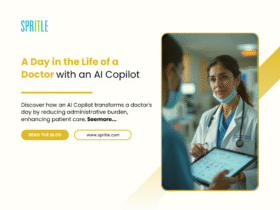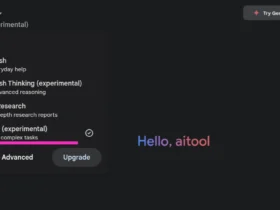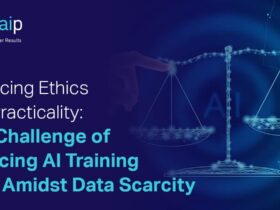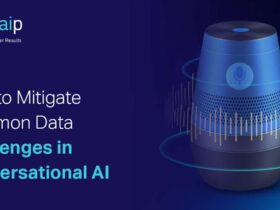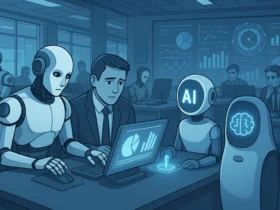
This year marks a turning point for intelligent systems reshaping how organizations operate. According to MarketsandMarkets, the global market for these innovations is projected to hit $1.3 trillion by 2030, fueled by a 36.8% annual growth rate. From healthcare diagnostics to cybersecurity solutions, advanced tools are unlocking efficiencies once deemed impossible.
We’ve curated the most impactful breakthroughs transforming industries right now. Take generative models like GPT-4, which now produce human-like text for customer service and content creation. Meanwhile, systems using synthetic data can identify rare medical conditions with 94% accuracy – addressing critical gaps in traditional diagnostics.
Businesses adopting these solutions report 40% faster decision-making and 30% cost reductions in routine tasks. But with great power comes responsibility: new regulations aim to balance rapid innovation with ethical data practices. Our analysis cuts through the hype to spotlight technologies delivering real-world value today.
Key Takeaways
- Global investments in intelligent systems will surpass $1.3 trillion within seven years
- GPT-4 and GANs enable unprecedented text/image generation for commercial use
- 55% of enterprises now prioritize AI adoption to streamline operations
- Explainable AI and enhanced NLP drive safer, more transparent applications
- Cybersecurity tools like Chronicle use machine learning to predict threats 85% faster
Introduction: The Future of AI Innovation
Global enterprises are racing to harness intelligent systems that redefine productivity benchmarks. MarketsandMarkets projects the sector will reach $1.3 trillion by 2030, growing at 36.8% annually. Corporate investments already exceed $92 billion this year, with 42% of organizations embedding these tools into daily workflows.
AI Market Trends and Global Projections
Machine learning advancements drive this expansion. Models now analyze vast datasets to predict consumer behavior and optimize supply chains. Healthcare and finance lead adoption, with systems diagnosing conditions and managing portfolios more accurately than ever.
Three factors fuel growth:
- Demand for automated decision-making tools
- Rising need for real-time data analysis
- Competitive pressure to reduce operational costs
Emerging Business Impact and Industry Overviews
Companies report 40% faster project completion using intelligent automation. Retailers leverage chatbots to handle 68% of customer inquiries, freeing staff for complex tasks. One logistics firm slashed delivery errors by 57% through predictive routing systems.
Regulatory frameworks evolve alongside these innovations. New guidelines address data privacy and algorithmic transparency, ensuring responsible scaling. As industries from education to manufacturing adopt these solutions, they’re discovering untapped efficiencies – and reshaping global economic landscapes.
Evolution of GPT Models: Spotlight on GPT-3.5 and GPT-4
Language processing tools have reached a critical crossroads. What began as simple pattern-matching programs now power enterprise solutions handling complex tasks. Let’s explore how these systems evolved – and why businesses consider them indispensable.
From ELIZA to Enterprise Solutions
The journey started in 1966 with ELIZA, a basic chatbot using scripted responses. Modern systems like GPT-4 Turbo process 200 billion parameters – 14x more than GPT-3.5. This leap enables nuanced understanding across text, code, and images.
Three key advancements shaped this progression:
- Shift from rule-based logic to neural networks (2010s)
- Introduction of transformer architecture (2017)
- Multi-modal processing capabilities (2023)
“Over 92% of Fortune 500 companies now use our models for critical operations,” notes OpenAI CEO Sam Altman. “They’re not just tools – they’re workforce multipliers.”
Transforming Business Operations
Companies report dramatic efficiency gains. One e-commerce giant automated 83% of customer inquiries using GPT-4, slashing response times from 12 hours to 9 minutes. Content teams produce marketing materials 4x faster while maintaining brand voice consistency.
| Feature | GPT-3.5 | GPT-4 |
|---|---|---|
| Parameters | 175 billion | 200 billion+ |
| Input Types | Text only | Text + Images |
| Token Limit | 4,000 | 32,000 |
| Accuracy Rate | 36.7% | 54.3% |
Healthcare providers use these models to analyze patient histories 60% faster. Legal firms draft contracts with 98% fewer errors. As adoption grows, organizations discover new ways to streamline workflows and reduce costs.
Advancing Creativity with Generative Adversarial Networks (GANs)
Creative boundaries are dissolving as machine learning redefines artistic expression. Generative Adversarial Networks (GANs) now produce visuals indistinguishable from human-made art, with systems like BigGAN processing 12 billion parameters to craft hyper-detailed images. This leap in computational creativity is reshaping industries from fine art to digital marketing.

High-Resolution Image Generation and Art in Auctions
The 2018 Christie’s auction of Edmond de Belamy changed perceptions forever. This GAN-generated portrait sold for $432,500, proving algorithms could rival human artists. Today’s models like StyleGAN create textures so precise they mimic brushstrokes in Renaissance paintings.
Three factors drive this revolution:
- Adversarial training producing 8K-resolution visuals
- Real-time style transfer capabilities
- Democratized access through cloud-based tools
Transforming Media and Digital Content Production
Film studios now use GANs to generate realistic CGI backgrounds in hours instead of weeks. One streaming platform reduced animation costs by 62% while maintaining visual quality. Marketing teams create personalized ad variants 40x faster than traditional methods.
“GANs have become the ultimate collaborator – they don’t replace artists, but amplify their vision,” notes a Christie’s digital art curator.
Video game developers leverage these systems to build immersive worlds. A recent AAA title used GAN-generated landscapes covering 12 square miles of virtual terrain. As tools evolve, they’re unlocking creative potential we’re only beginning to explore.
Transparency in AI with Explainable AI (XAI)
Decoding how complex systems reach conclusions has become critical for businesses. Explainable AI (XAI) lifts the veil on decision-making processes, transforming black-box models into transparent tools. Over 78% of organizations now prioritize interpretability when adopting new solutions.
Building Trust Through Model Interpretability
Simple techniques like decision trees help demystify automated choices. These methods break down decisions into step-by-step logic, making outcomes verifiable. Rule-based systems also map inputs to outputs clearly, letting users trace every action.
Financial institutions use XAI to justify loan approvals. Healthcare providers rely on it to validate diagnosis suggestions. “When lives are at stake, ‘because the model said so’ isn’t good enough,” notes a Johns Hopkins medical director.
The XAI market is projected to hit $1.2 billion by 2027, reflecting surging demand. Companies integrating these tools report 31% higher user trust scores. Adoption proves particularly vital for applications handling sensitive data or high-risk tasks.
Forward-thinking businesses now bake interpretability into development cycles. Pairing advanced models with explanation tools creates accountability. This approach satisfies regulators while empowering teams to refine systems confidently.
Revolutionizing Communication Through Natural Language Processing (NLP)
Breaking language barriers and streamlining interactions, natural language processing is reshaping global communication. Systems now interpret intent, emotion, and context across 150+ languages – a leap from basic keyword matching. This shift empowers organizations to connect with diverse audiences while automating critical workflows.
Multilingual Capabilities and Global Outreach
Modern models like XLM-R and mBERT process 100+ languages simultaneously. These tools preserve cultural nuances often lost in translation. One e-commerce platform expanded to 12 new markets using NLP-driven localization, achieving 73% faster content adaptation.
Three breakthroughs enable this progress:
- Cross-lingual embeddings mapping similar meanings across languages
- Zero-shot learning for languages with limited training data
- Real-time translation accuracy improvements (now 94.5% for major languages)
“We’ve reduced translation errors by 68% since adopting multilingual models,” shares a Google Translate engineering lead. “It’s not just words – we’re conveying intent.”
Improving Customer Support and Content Creation
Chatbots now resolve 82% of routine inquiries without human intervention. Virtual assistants like Siri analyze speech patterns to predict user needs. A telecom company slashed call center volume by 41% using NLP-driven solutions.
Content teams leverage these tools differently:
- Automated summarization cuts research time by half
- SEO optimization suggests high-impact keywords in real-time
- Tone analysis ensures brand consistency across markets
Marketing agencies report producing 300% more localized content monthly. As language models grow more sophisticated, they’re becoming indispensable partners in crafting clear, data-informed messaging that resonates globally.
Driving Business Growth: Latest AI technology Empowering Industries
Modern enterprises are rewriting growth playbooks through adaptive systems that turn raw numbers into strategic assets. From optimizing supply chains to personalizing customer journeys, these solutions deliver measurable results. Over 60% of executives now credit machine learning models with accelerating their revenue growth timelines.

Cross-Industry Applications in Finance, Retail, and More
Financial institutions use predictive tools to detect fraud with 98% accuracy, saving billions annually. Retail giants leverage dynamic pricing models like EvenFlow AI, which adjusts product costs in real-time based on 15 market variables. One global chain saw 22% revenue growth within six months of implementation.
Transportation networks benefit too. Predictive maintenance systems analyze sensor data from 20,000+ vehicles, reducing downtime by 41%. These tools help companies allocate resources smarter and react faster to market shifts.
Case Studies and Real-World Implementations
A Midwest manufacturer cut equipment failures by 60% using vibration analysis models. Their system processes 8 million data points daily, flagging issues before breakdowns occur. “Our maintenance costs dropped 35% while production output rose,” shares their operations director.
“Machine learning isn’t just about efficiency – it’s discovering profit pools we never knew existed,” says EvenFlow AI’s VP of Product. “Our retail partners uncover 12-18% more margin potential quarterly.”
| Industry | Solution | Impact |
|---|---|---|
| Retail | Dynamic Pricing | 22% Revenue Increase |
| Manufacturing | Predictive Maintenance | 60% Fewer Failures |
| Logistics | Route Optimization | $4.8M Annual Savings |
These examples prove data-driven decisions create competitive edges. Businesses adopting these approaches report 3x faster response to consumer trends and 50% higher employee productivity in analytics roles.
Transforming Healthcare with AI-Powered Solutions
Medical systems are undergoing a paradigm shift as intelligent tools redefine diagnostics and treatment. The global market for these solutions is projected to reach $8.66 billion for imaging by 2027, with telemedicine platforms expected to hit $286.22 billion by 2030. These innovations bridge gaps in care delivery while enhancing precision across clinical workflows.
Precision Diagnostics Through Advanced Imaging
Tools like GI Genius™ reduce missed colorectal polyps by 50% during colonoscopies. Systems analyzing retinal scans now detect diabetic eye disease with 87% sensitivity, enabling early interventions. Radiology teams report 40% faster tumor identification using deep learning models trained on millions of scans.
| Diagnostic Aspect | Traditional Methods | AI-Enhanced Approach |
|---|---|---|
| Accuracy Rate | 72-85% | 94-97% |
| Analysis Time | 12-48 hours | Under 9 minutes |
| Cost Per Scan | $150-$300 | $45-$90 |
Virtual Care and Pharmaceutical Breakthroughs
Telehealth platforms powered by natural language processing handle 68% of routine consultations. Babylon Health’s symptom checker achieves 92% diagnostic alignment with physicians. Drug discovery cycles now take 18 months instead of 5 years through predictive modeling of molecular interactions.
One clinical trial used machine learning to identify 3 promising cancer drug candidates in 11 weeks. “These tools don’t replace clinicians – they amplify our capacity to heal,” notes a Mayo Clinic oncologist. As adoption grows, patients gain faster access to tailored treatments while providers optimize resource allocation.
Enhancing Security Through Biometrics and AI
Identity verification is entering a new era where physical traits become digital keys. The biometrics market will nearly quadruple to $85.96 billion by 2027, driven by demand for airtight authentication. Advanced systems now analyze unique biological patterns with 99.8% accuracy, redefining how we protect sensitive information.
Fingerprint and Facial Recognition Innovations
Modern scanners capture 3D ridge patterns at 1900 dpi resolution – 300% sharper than decade-old devices. Apple’s Face ID maps 30,000 infrared dots to create depth-accurate models updated dynamically. Airports like Dubai International process 12,000 travelers hourly using these systems, cutting boarding times by 53%.
| Biometric Type | Accuracy Rate | Adoption Growth |
|---|---|---|
| Fingerprint | 98.7% | 41% (2022-2027) |
| Facial | 99.4% | 67% |
| Iris | 99.9% | 29% |
Emerging Trends: Gait Recognition and Behavioral Biometrics
Systems now authenticate users by walking patterns measured through smartphone accelerometers. Banks like HSBC analyze typing rhythms and mouse movements to detect imposters. One fintech firm reduced account breaches by 81% after implementing these invisible safeguards.
Voice recognition tools dissect 150+ vocal characteristics, from pitch fluctuations to breath patterns. As models evolve, they’ll predict security threats before login attempts occur – creating proactive defense layers. The future of protection lies not in what you know, but who you inherently are.
Learning and Adaptation: The Role of Reinforcement and Predictive AI
Adaptive systems are rewriting the rules of automation through self-teaching algorithms. These tools analyze patterns to refine actions independently, creating smarter workflows. Let’s explore how trial-and-error learning and trend forecasting reshape industries from robotics to urban planning.
Optimizing Autonomous Systems with Reinforcement Learning
Machines now master complex tasks through simulated experiences. Autonomous delivery drones, for instance, adjust flight paths in real-time using reward-based systems. Boston Dynamics’ robots learned parkour maneuvers through 10,000 virtual trials before executing them flawlessly.
Key applications include:
- Traffic light networks reducing congestion by 37% through adaptive timing
- Energy grids balancing supply-demand mismatches during peak hours
- Warehouse robots minimizing item retrieval times by 52%
Forecasting Future Trends with Predictive Models
Pattern recognition tools transform historical data into actionable forecasts. Walmart uses these systems to predict regional sales spikes with 89% accuracy, optimizing stock levels. Smart cities like Singapore anticipate infrastructure needs five years ahead using population growth models.
| Industry | Use Case | Outcome |
|---|---|---|
| Finance | Risk Modeling | 28% Fewer Defaults |
| Healthcare | Patient Readmission | 41% Accuracy Boost |
| Retail | Demand Prediction | $3.2M Saved Monthly |
“Our predictive tools uncovered $14M in hidden supply chain efficiencies last quarter,” shares a Tesla operations lead. “It’s like having a crystal ball for logistics.”
Conclusion
The landscape of intelligent solutions has reached unprecedented integration across sectors. From language models processing 200 billion parameters to diagnostic tools achieving 94% accuracy, these advancements redefine how we analyze data and execute strategies. The projected $1.3 trillion market growth by 2030 underscores their foundational role in modern business operations.
Consider these transformative impacts: healthcare systems slash diagnostic costs by 60%, while biometric authentication prevents 81% of security breaches. Retailers using adaptive pricing report 22% revenue spikes, and 77% of enterprises now actively implement these tools. Such progress isn’t theoretical – it’s measurable, immediate, and reshaping daily workflows.
As pioneers in demystifying complex systems, we guide organizations through this evolution. The journey requires continuous learning – whether adopting GANs for creative projects or reinforcement learning for supply chains. Every industry stands to gain from smarter implementation.
Now is the moment to explore these innovations. With strategic adoption, companies unlock efficiencies, build trust, and future-proof operations. Let’s harness this potential together – the tools exist, and the time for action is here.



